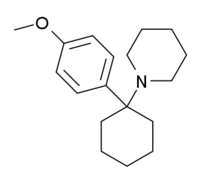4-MeO-PCP
4-Methoxyphencyclidine (methoxydine, 4-MeO-PCP) is a dissociative anesthetic drug that has been sold online as a research chemical. The synthesis of 4-MeO-PCP was first reported in 1965 by the Parke-Davis medicinal chemist Victor Maddox.[1] A 1999 review published by a chemist using the pseudonym John Q. Beagle suggested the potency of 4-MeO-PCP in man was reduced relative to PCP, two years later Beagle published a detailed description of the synthesis and qualitative effects of 4-MeO-PCP, which he said possessed 70% the potency of PCP.[1] 4-MeO-PCP was the first arylcyclohexylamine research chemical to be sold online, it was introduced in late 2008 by a company trading under the name CBAY and was followed by several related compounds such as 3-MeO-PCP and methoxetamine.[1][2] 4-MeO-PCP has lower affinity for the NMDA receptor than PCP, but higher affinity than ketamine, it is orally active in a dosage range similar to ketamine, with some users requiring doses in excess of 100 mg for desired effects.[1][3] Users have reported substantial differences in active dose, these discrepancies can be partially explained by the presence of unreacted PCC and other impurities in samples sold on the grey market.[1] 4-MeO-PCP has Ki values of 404 nM for the NMDA receptor, 713 nM for the norepinephrine transporter, 844 nM for the serotonin transporter, 296 nM for the σ1 receptor and 143 nM for the σ2 receptor.[3]
 | |
| Clinical data | |
|---|---|
| ATC code |
|
| Legal status | |
| Legal status |
|
| Identifiers | |
IUPAC name
| |
| CAS Number |
|
| ChemSpider | |
| UNII | |
| CompTox Dashboard (EPA) | |
| Chemical and physical data | |
| Formula | C18H27NO |
| Molar mass | 273.420 g·mol−1 |
| 3D model (JSmol) | |
SMILES
| |
InChI
| |
| | |
4-MeO-PCP hydrochloride is a white crystalline solid with a melting point of 181-182 °C[4]
Side effects
4-MeO-PCP has caused a fatality in combination with 4-HO-MET, venlafaxine, olanzapine, lorazepam and hydroxyzine.[5]
Legality
On October 18, 2012 the Advisory Council on the Misuse of Drugs in the United Kingdom released a report about methoxetamine, saying that the "harms of methoxetamine are commensurate with Class B of the Misuse of Drugs Act (1971)", despite the fact that the act does not classify drugs based on harm. The report went on to suggest that all analogues of MXE should also become class B drugs and suggested a catch-all clause covering both existing and unresearched arylcyclohexamines, including 4-MeO-PCP.[6]
Sweden's public health agency suggested classifying 4-MeO-PCP as hazardous substance on November 10, 2014.[7]
As per Chile's Ley de drogas, aka Ley 20000,[8] all esters and ethers of PCP are illegal. As 4-MeO-PCP is an ether of PCP, it is thus illegal.
See also
- Arylcyclohexylamine
- 3-HO-PCP
- 3-MeO-PCE
- 3-MeO-PCMo
- 3-MeO-PCP
- Methoxetamine
- Methoxyketamine
References
- Morris, H.; Wallach, J. (2014). "From PCP to MXE: a comprehensive review of the non-medical use of dissociative drugs". Drug Testing and Analysis. 6 (7–8): 614–632. doi:10.1002/dta.1620. PMID 24678061.
- [King LA. New drugs coming our way - what are they and how do we detect them? EMCDDA Conference, Lisbon, 6–8 May 2009 http://www.emcdda.europa.eu/attachements.cfm/att_78745_EN_4_King.pps]
- Roth, B.; Gibbons, S. (2013). "The Ketamine Analogue Methoxetamine and 3- and 4-Methoxy Analogues of Phencyclidine Are High Affinity and Selective Ligands for the Glutamate NMDA Receptor=PLoS ONE". PLoS ONE. 8 (3): e59334. doi:10.1371/journal.pone.0059334. PMC 3602154. PMID 23527166.
- Wallach J, De Paoli G, Adejare A, Brandt S (2013). "Preparation and analytical characterization of 1-(1-phenylcyclohexyl)piperidine (PCP) and 1-(1-phenylcyclohexyl)pyrrolidine (PCPy) analogues". Drug Testing and Analysis. 6 (7–8): 633–650. doi:10.1002/dta.1468. PMID 23554350.
- Iain M. McIntyre; Amber Trochta; Ray D. Gary; Alina Storey; Jennifer Corneal; Bethann Schaber (August 2015). "A Fatality Related to Two Novel Hallucinogenic Compounds: 4-Methoxyphencyclidine and 4-Hydroxy-N-methyl-N-ethyltryptamine". Journal of Analytical Toxicology. 39 (9): 751–755. doi:10.1093/jat/bkv089. PMID 26265285.
- "(ACMD) Methoxetamine Report (2012)" (PDF). UK Home Office. 2012-10-18. p. 14. Retrieved 2012-10-22.
- "Cannabinoider föreslås bli klassade som hälsofarlig vara". Folkhälsomyndigheten. Retrieved 29 June 2015.
- "SUSTITUYE LA LEY Nº 19.366, QUE SANCIONA EL TRAFICO ILICITO DE ESTUPEFACIENTES Y SUSTANCIAS SICOTROPICAS" (in Spanish). Bibloteca Del Congreso Nacional. 22 October 2015. Retrieved 6 February 2018.